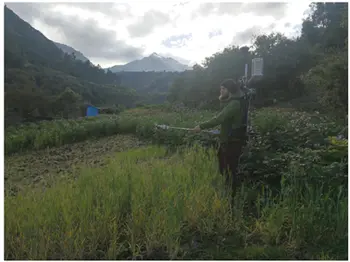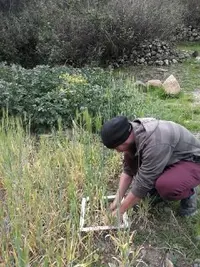 Eddy Covariance station on a potato field at the Cordillera Blanca (Credit: Lorenz Hänchen)
Eddy Covariance station on a potato field at the Cordillera Blanca (Credit: Lorenz Hänchen)
In 2019, I joined the interdisciplinary team of AgroClim Huaraz and became a member of the Biometeorology working group at the Institute of Ecology as a PhD student. I am lucky to have the opportunity to both work in the field and in the office. Due to the variety of tasks in our project I am acquiring many new skills ranging from data analytics, improving my Spanish in communication with Peruvian locals, gaining some basic electronic skills, while maintaining measurement stations and many many more.
 Peruvian Andes Peruvian Andes (Credit: W. Gurgiser)
Peruvian Andes Peruvian Andes (Credit: W. Gurgiser)
The climate in the semi-arid Peruvian Andes is very different from what we are used to here in the Alps. It is characterized by a strong seasonality in precipitation, the majority occurring between October and May. Many people who live in the mountains rely on rain-fed agriculture for their livelihoods and these farmers report increasing challenges for crop production due to climate change. There is a general lack in observation data (e.g. by automatic weather stations) in the region and to date the available meteorological data does not match the perception of the local farmers. Our goal in the project is to close this knowledge gap regarding both water demand and water availability to enable the development of effective adaptation strategies.
 EcoBot mobile measurement device (Credit: R. Cruz Encarnación)
EcoBot mobile measurement device (Credit: R. Cruz Encarnación)
Particularly, I am identifying how various crops in rain-fed agriculture differ in terms of energy balance and especially water-use (i.e. evapotranspiration) along a precipitation transect ranging from the glaciated Coordillera Blanca (relatively high annual precipitation) to the unglaciated Coordillera Negra (relatively lower annual precipitation). To measure this, we set up an Eddy Covariance station on a potato field at the Coordillera Blanca in Sep. 2019, take regular biomass samples and use the EcoBot mobile measurement device to measure more crops and plots along the transect. Due to the current COVID-19 crisis we lost some data and our Peruvian partners could not continue the measurements we started last year. But I hope, we can continue our measurements in the near-future, of course depending on the development of the pandemic.
Meanwhile, I am working with remote sensing data to understand phenological changes over time (since 2000) and how they correlate with reanalysis data of precipitation to understand whether amounts or the seasonality of precipitation have changed in the phenological cycle of agriculture.

Fieldwork (Credit: R. Cruz Encarnación)
In future, I aim to use our novel field data to calibrate a popular crop model (AquaCrop). First, it will be used on plot-scale and later on regional scale by integrating remote sensing data, iterative parameter estimations and high-resolution climate data on which my colleagues at the ACINN are currently working. With this model-ensemble we will be able to estimate the statistical likelihood of potential threats to successful agriculture. In this context I am also interested whether past (and likely future) changes in precipitation have affected (or are likely to affect) the yield of the crops in the study area. By extrapolating potential trends of threats into the near-future, an agro-climatic risk assessment of certain agricultural management practices will be an additional result.
I am very happy to have such an interesting job with many different tasks and learning opportunities. I hope, that my work can contribute to progress in the scientific community on the one hand and to climate change adaptation strategies on the other.
Lorenz Hänchen
Reposted from the Insitute for Ecology website